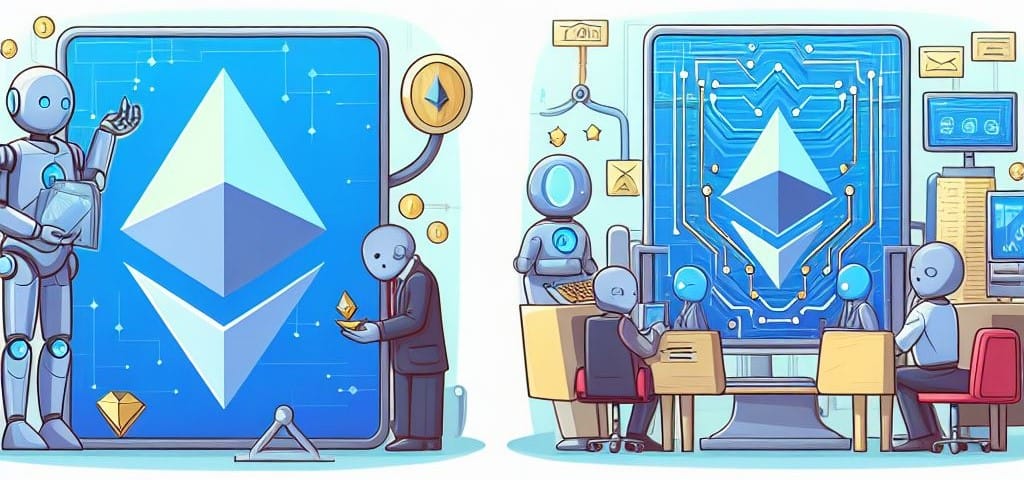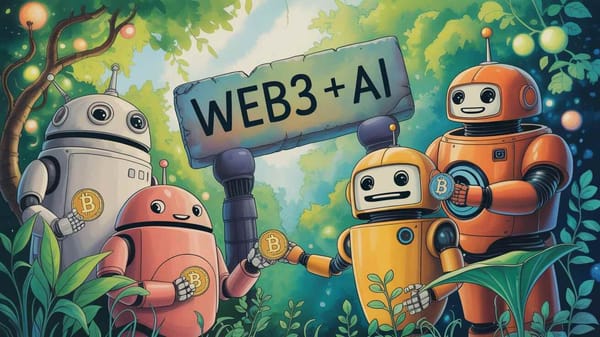On the Convergence of AI and DAOs

Hello, everyone, and warm welcome to all newly joined subscribers!
This is the Web3 + AI newsletter, where we explore the intersection of blockchain and artificial intelligence. It is my pleasure to present to you Web3 + AI's second guest writer Giannis Rousopoulos. Giannis is Senior Policy Advisor at the Hellenic Parliament, founder of cryptonomist.gr, Scientific Associate at Hellenic Financial Literacy Institute, Country Ambassador of Serenity Shield, Mentor at DeFi Talents, Bitcoin Talents and Athens Center for Entrepreneurship and Innovation.
Giannis is here to share his musings on the benefits of converging AI and blockchain, especially in the case of AI employed by a DAO, a decentralized autonomous organization. He has recently launched his own newsletter dedicated to the AIxBlockchain Fusion, so make sure you subscribe to it too.
Thank you for being here! Let's dive in!
In the realm of DAOs, the convergence with AI represents a leap towards unprecedented efficiency and strategic depth. AI's integration into DAOs isn't just a theoretical enhancement; it's a practical evolution that brings a range of tangible benefits. For instance, AI's advanced data analysis capabilities enable DAOs to parse through vast amounts of information, extracting actionable insights that can inform governance decisions and optimize operational workflows.
One of the most exciting applications of this convergence is in predictive governance. AI can forecast the potential outcomes of governance proposals based on historical data, helping DAO members make more informed decisions. This predictive power is particularly valuable in financial DAOs, where AI can analyze market trends and assist in shaping investment strategies, potentially leading to higher returns and more robust financial health for the DAO.
Moreover, in the realm of community governance, AI can play a pivotal role in synthesizing community input. By analyzing member proposals and feedback, AI can help identify common themes and consensus points, streamlining the decision-making process. This can enhance member engagement and satisfaction, as the governance process becomes more efficient and reflective of the community's collective voice.
In terms of operational efficiency, AI-driven automation can manage routine tasks and complex operations within DAOs, freeing up human resources for more strategic activities. This includes optimizing resource allocation, managing DAO treasuries, and even automating certain aspects of compliance and reporting.
Furthermore, AI's predictive analytics can play a crucial role in risk assessment and mitigation within DAO governance. By foreseeing potential challenges and vulnerabilities, AI empowers DAOs to proactively address these issues before they escalate, ensuring smoother and more stable governance operations.
In the context of DAO governance, AI can significantly enhance consensus mechanisms. For instance, consider a DAO facing complex governance decisions that require analyzing vast amounts of historical data and community inputs. AI algorithms can be employed to process this data, identify patterns, and predict the potential outcomes of different governance proposals. This process not only accelerates decision-making but also ensures that decisions are data-driven and aligned with the DAO's historical values and objectives.
Imagine a DAO that oversees a DeFi platform. Using AI, this DAO can analyze past voting patterns, financial data, and market trends to predict the impact of proposed changes to the platform's protocols or fee structures. The AI system can present these predictions to DAO members, aiding them in making informed decisions that balance profitability with user experience, ultimately leading to more effective and democratic governance.
Another area where AI can significantly contribute to DAO governance is in proactive risk management. By leveraging predictive analytics, AI can foresee potential risks and challenges that the DAO might encounter. This foresight allows the DAO to implement measures, minimizing the impact of those risks.
For example, a DAO managing a decentralized insurance pool could use AI to analyze historical claim data, market conditions, and emerging trends to predict future claim patterns. This predictive insight enables the DAO to adjust its insurance models and reserve requirements proactively. As a result, the DAO ensures its long-term financial stability while maintaining fair premiums and coverage for its users. The AI's predictive capabilities thus empower the DAO with strategic foresight, enabling it to navigate uncertainties more effectively and sustainably.
In the evolution of Network States, AI emerges as a critical catalyst for their development and governance. A Network State, characterized by its moral innovation and a system of government bounded by social smart contracts, can leverage AI to optimize and streamline its foundational processes.
AI's first contribution is in enhancing the decision-making processes of these Network States. By analyzing data from various sources, including social networks and on-chain activities, AI can provide insights into the preferences and needs of the network community. This analysis allows for more informed and democratic decision-making processes, ensuring that the actions of the network state align with its members' collective will.
Furthermore, AI can play a pivotal role in the management and allocation of the network state's resources. AI can assist in analyzing market trends, predicting investment outcomes, and managing the network state's treasury with high efficiency and transparency.
AI also enhances the scalability and sustainability of Network States. Through predictive analytics and intelligent forecasting, AI can help these states anticipate challenges and adapt their strategies accordingly. In addition, by processing and synthesizing communication patterns, cultural preferences, and community feedback, AI can aid in fostering a cohesive and engaged online community. This strengthens the identity and unity of the Network State, crucial for its long-term viability and success.
Thoughts on the convergence of AI and Blockchain
The integration of blockchain into AI's 'black box' is a groundbreaking development, offering unprecedented levels of transparency and auditability. Blockchain’s immutable, tamper-proof ledger transforms the way we understand and interact with AI systems. It does more than just record transactions; it provides a window into the AI decision-making process, enabling stakeholders to trace and understand how AI models are trained, how data is weighted, and identify any anomalies or biases in the data.
The potential of this convergence is vast and diverse. About 51% of businesses surveyed in a recent report from Casper Labs recognize that employing blockchain to enhance AI’s efficiency is not just a strategic move, but a necessary evolution. The synergy of AI’s analytical and predictive capabilities with the robust, secure framework of blockchain opens up revolutionary possibilities across industries. In finance, for example, this convergence could lead to more robust fraud detection systems, where AI’s predictive analytics are supported by blockchain’s immutable record-keeping, enhancing both the accuracy and credibility of the fraud detection mechanisms.
In the short term, we are witnessing user expectations rapidly evolving as Web2 seamlessly integrates AI into applications, significantly enhancing user experience and interface. This progression sets a high bar for Web3, which must rise to the occasion before the gap in user experience becomes too wide to bridge. We are tasked with not just observing this shift, but actively engaging in molding it.
As we pivot our focus to fixing the internet, we confront the stark reality that the current state of the web is chaotic and disjointed. The promise of salvation lies in the collaborative synergy of AI and blockchain—where intelligent, adaptive user interactions powered by AI meet the unyielding integrity and security offered by blockchain's decentralized ledgers.
The long-term perspective reveals technological limitations that were once masked by the novelty of AI and blockchain. As the initial sheen fades, these limitations become glaringly apparent, prompting these technologies to seek answers within each other's capabilities.
I truly believe that the most exciting days of this technological fusion are indeed ahead of us, promising a landscape where AI and blockchain work in tandem to revolutionize not just businesses but also societal structures and norms.
Disclaimer: None of this should or could be considered financial advice. You should not take my words for granted, rather, do your own research (DYOR) and share your thoughts to create a fruitful discussion. Moreover, guest posts express solely the author's opinions and do not necessarily represent the position of the Web3 + AI publication.




